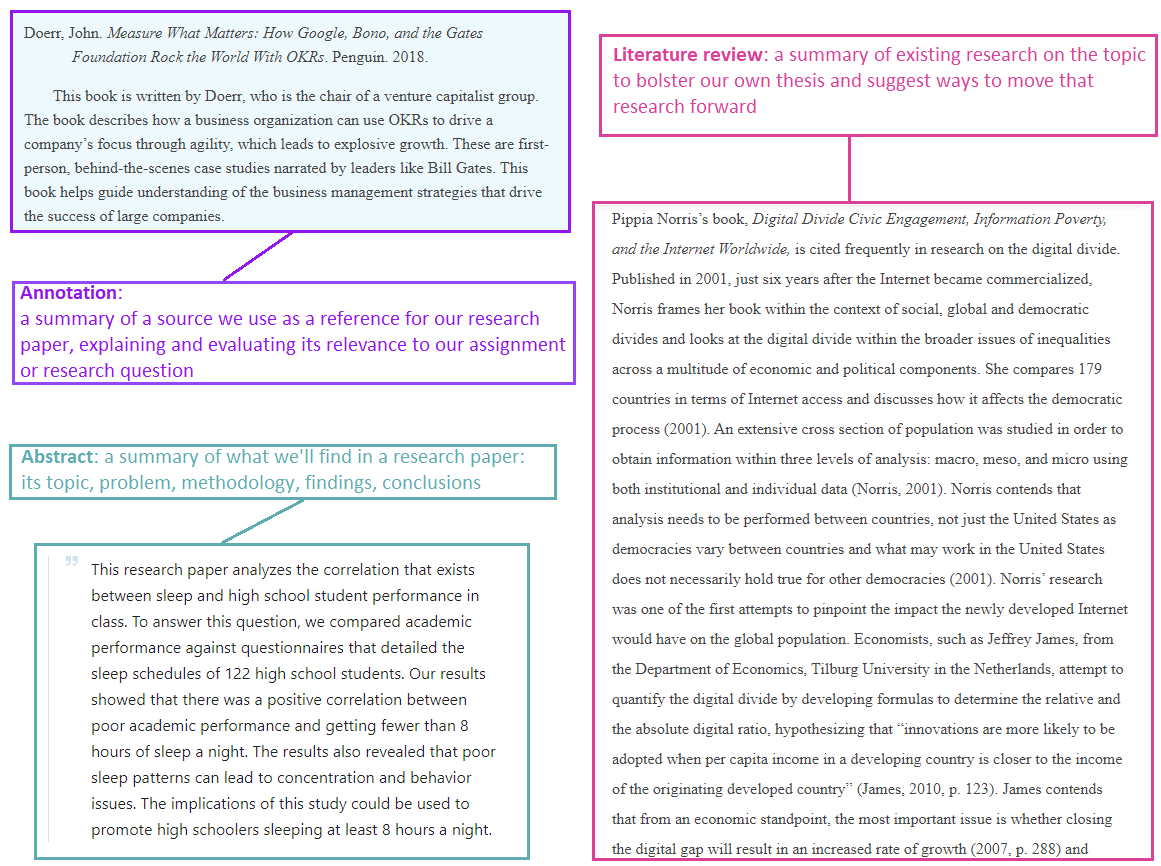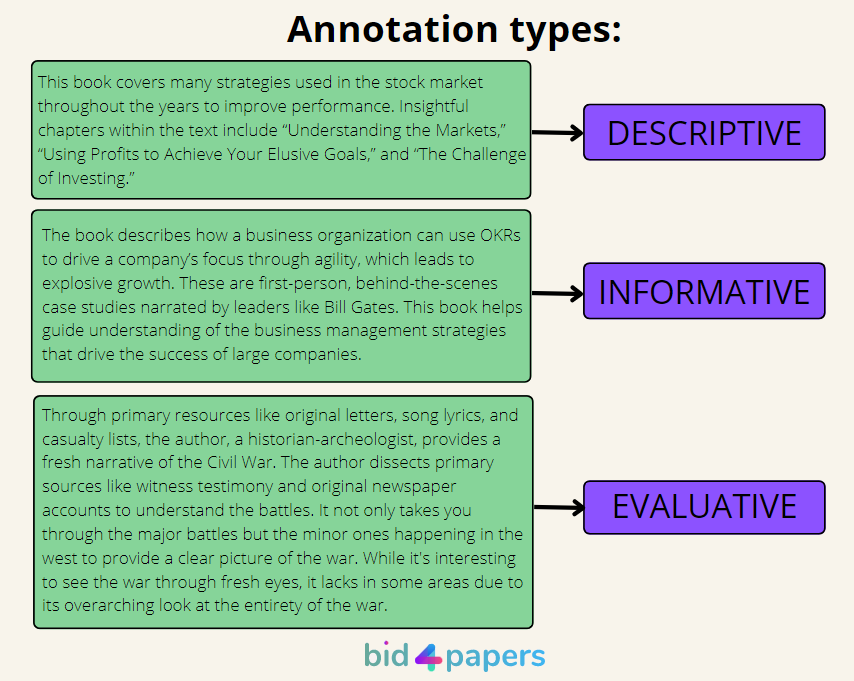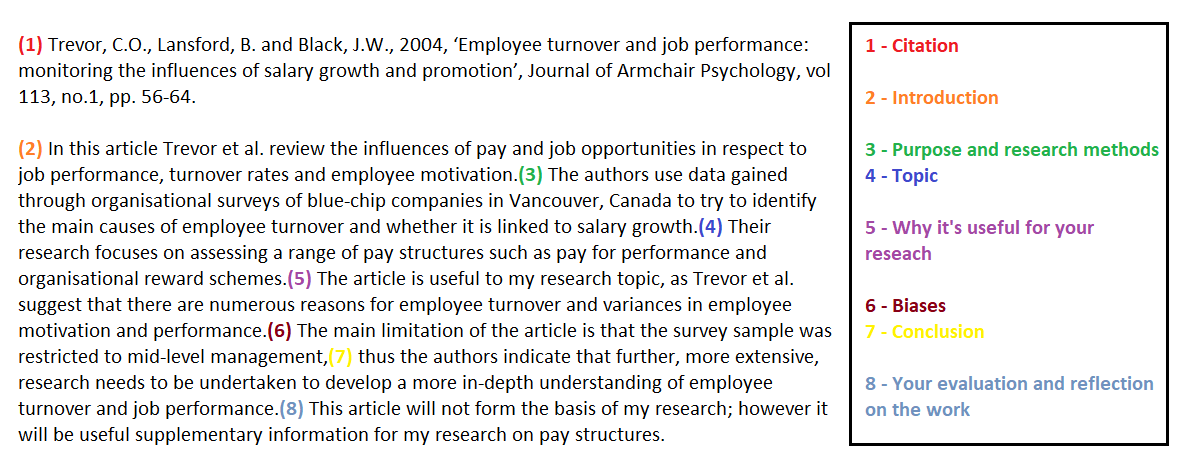
How to Write an Annotated Bibliography: Formats, Types, Steps
In this blog post, you’ll learn how to write an annotated bibliography for research papers.
While many students and writers find this process challenging and stressful, an annotated bibliography is not that hard to craft. The trick is to decide on its type and format and follow the steps we reveal here.
Let’s jump into details.

Table of Contents:
What is an Annotated Bibliography?
When writing a citation, you need to format it using a consistent style. The most common citation styles are APA (American Psychological Association), MLA (Modern Language Association), and Chicago. Read your assignment carefully to see which one your instructor prescribed or, if no particular citation style assigned, choose a formatting style depending on the type of your research paper:
- APA is for Behavioral and Social Sciences (business, psychology, sociology, communication).
- MLA goes to Humanities (languages, arts, culture).
- Chicago is for History and occasionally for Sciences.
When writing an annotation, you can assess the source’s strengths and weaknesses, outline its main arguments, mention the info about its authors and their conclusions, or specify its relevance to your research topic.
An annotated bibliography may be a stand-alone task or a component of your assignment. In the case of the latter, it would help to craft it before writing a draft of your research paper. It will allow you to see where to mention this or that source from your bibliography throughout the text.
Abstract vs. Annotation vs. Literature Review
When writing annotations, it’s critical to understand how they are different from abstracts or literature reviews. While all three are summaries, you shouldn’t mix them up when working on a research paper.
Abstract:
An abstract is a part of a research paper. Many scholarly articles start with abstracts, summarizing the topic, problem, methodology, and findings, thus helping readers understand whether this paper is relevant for them to check. After checking the abstract, they can decide whether they want to read the entire article.
Literature Review:
A review ties together the previously published research on the topic, helping an author to define and state a thesis. It summarizes previous studies, identifies gaps, and suggests how to move the existing research forward to the next step.
Annotation:
An annotation is a note about a citation listed on a research paper bibliography. It summarizes the source and explains (evaluates) why it’s relevant and critical for the paper’s topic. The author of a research paper writes an annotation in their own words.

The Purpose of Writing Annotated Bibliographies
And now, to the question bothering most students:
We can almost hear you crying, “Why should I write an annotated bibliography with my paper? Wouldn’t it be enough to list citations?”
Okay, we feel your pain, but that’s how the academic world works. Whether you learn with online course sellers or choose traditional education in school or college, the purpose of annotated bibliographies is to describe and evaluate the sources you use to write a paper.
An annotated bibliography:
- Illustrates the scope of your research
- Reviews the literature already published on your topic
- Provides a reader with alternative resources to check on your topic
- Allows readers to see if a particular resource is worth considering
- Places your research in a historical context
And, (surprise-surprise!) an annotated bibliography is not for your teacher who’s assigned it. It helps you create a reference list, summarizing the sources to more critically delve into the topic and better understand it to craft a strong thesis for your research paper.
How to Write an Annotated Bibliography
That’s all good and well, but it’s time to learn how to write an annotated bibliography step by step, agree?
Here’s what you need to do:
Choose Sources
First and foremost, search for the sources you’ll refer to when writing your paper. Decide on source types you’ll include: Will it be books, websites, primary documents, articles, or anything else?
Also, remember the number of sources to mention: Sometimes, a teacher sets it in the guidelines; sometimes, it’s up to you to decide how many references you’ll need.
Make a list of all found resources that might be relevant, but don’t hurry up to write annotated bibliography for each. After reviewing and evaluating them, some may happen to be irrelevant.
Review the Items
Now it’s time to review the sources to check if they are worth using for your research. The process is time-consuming and covers two steps:
- Initial appraisal (reviewing the source)
- Critical analysis of the source
The first step is to look at the source’s study date. New research and movements happen, and you must ensure this source is still relevant to your topic.
Also, check the author’s credentials and qualifications. Where they work, their educational background and area of expertise, their past writings, etc. Have you seen this author cited by others? Does the academic world consider this author reputable?
Note the publisher: Is it a scholarly journal? Is it the first edition of that research or the revised and updated one?
The initial look will help you understand if the source is worth your further investigation and evaluation. The CRAAP test may come in handy here: Ensure your chosen item is current, relevant, authoritative, accurate, and purposeful to continue working with it.

After the initial appraisal, critical evaluation comes. Read the sources: examine the preface, scan the table of contents to see if something addresses your topic, and determine the author’s intentions. Remember to note your findings and impressions.
Consider:
- Intended audience: Is it specialized or general? Is the source too elementary, advanced, or suitable to your needs?
- Reasoning: Is the information valid and well-researched? Does the author verify their opinion with factual information and evidence? Is the language free of bias?
- Coverage: Does the source relate to the topic of your research? Does it provide arguments you didn’t find in other sources but would like to mention in your research paper?
Once you’ve selected the final group of sources for your annotated bibliography, let’s format them accordingly.
Write the Citation Using a Proper Format
As already mentioned, an annotated bibliography consists of two parts: a citation and an annotation itself. First, let’s cite all your sources using a proper format (citation style).
Citation styles are many, and the one you choose depends on the academic discipline involved in your research. The top three styles are as follows:
- APA (American Psychological Association) is for Education, Psychology, and Sciences niches.
That’s the example of a citation with APA:
Waite, L. (1986). Nonfamily living and the erosion of traditional family orientations among young adults. American Sociological Review, 51, 541-554.
- MLA (Modern Language Association) style is for Humanities.
That’s what it looks like in citations:
Waite, Linda J. "Nonfamily Living and the Erosion of Traditional Family Orientations Among Young Adults." American Sociological Review, vol. 51, no. 4, 1986, pp. 541-554.
- Chicago/Turabian style is for Business, History, and Fine Arts.
Here’s the example:
Waite, Linda J. "Nonfamily Living and the Erosion of Traditional Family Orientations Among Young Adults." American Sociological Review 51, no. 4 (Winter 1986): 541-554.
If you aren’t sure which one to use in your work, consult with a teacher. It’s a common practice to email them when questions appear.
Write the Annotation
After the citation, an annotation comes. It’s a paragraph of around 150 words you write for each source in your reference list. And please, don’t mention a source more than once.
It’s critical to understand that you can write an annotation in three different ways, depending on your intent. You can make it descriptive, informative, or evaluative, or write it as a combination of all three. Read your assignment carefully to include what your teacher asks; if nothing’s prescribed, feel free to format your annotation the way you like:
1) Descriptive annotations
It’s easy: Describe the source, mentioning its main topic and chapters.
2) Informative annotations
This one is about summarizing the main arguments covered in the source to show why it’s essential to include them in your reference list.
3) Evaluative annotations
Here you use the principle of compare and contrast to explain the goal of the source and why it fits your research topic.
Below are all three with examples:

As you see, an annotation should include most of the following elements:
- The source’s format and content
- The purpose of a cited work
- Its intended audience
- The value of an annotated source, and its significance for your research
- The author’s main arguments
- Biases in work, if any
- Your impression (evaluation) of the work
Remember that it’s not a review! You have one paragraph to annotate the source, so focus on brevity.
Annotated Bibliography Examples
Here goes an annotated bibliography example, including all the elements it might have. Please note that it’s not a one-size-fits-all example: Different annotated bibliography types and citation styles have a place to be, so ensure you follow your faculty’s preferred format.

Feel free to check the following resources for more examples of different types and citation styles:
- Annotated Bibliography Samples from Purdue University
- MLA Style Bibliographies from the University of North Florida
- Annotated Bibliographies from SIUC Writing Center
FAQ — Frequently Asked Questions
-
How to write an annotated bibliography step by step?
You’ll need to take four steps when writing an annotated bibliography for your research paper. First, choose sources you’ll add to your list of references; then, you’ll need to examine each of them to see if they are credible and relevant enough to mention in your work. The third step is to write a citation: Please remember to follow a prescribed format – APA, MLA, Chicago, etc. Finally, write an annotation paragraph: You can make it descriptive, informative, or evaluative.
-
What are the three parts of an annotated bibliography?
An annotated bibliography consists of three parts: a title, a citation, and an annotation. The first two may differ in formatting, depending on the citation style you’ll need to follow. An annotation is a paragraph describing your source and explaining why it’s essential for your research to refer to it.
-
What are the three types of annotation?
Three annotation types are description (indicative annotations), summary (informative annotations), and reflection (evaluative annotations). It’s up to you which type to choose for your work: It depends on your intention, or your teacher (instructor) can prescribe a particular writing style to follow.
-
How to format an annotated bibliography?
First, you write a citation in either APA, MLA, or Chicago format: It includes the information about the author(s), the work’s title, the publishing date, etc. After the citation, an annotation comes: It’s a paragraph describing the content of your source and explaining why you refer to it in your paper.
-
How to write an annotated bibliography MLA?
MLA (Modern Language Association) is a citation style used for research papers in Humanities. When you need to write an annotated bibliography in MLA, it means formatting your citation with proper punctuation rules. (See the example above in this guide.) An annotation paragraph itself doesn’t require any specific grammar/punctuation rules.
-
How to write an annotated bibliography APA?
APA (American Psychological Association) is a citation style used for research papers in Education, Psychology, and Sciences. When you need to write an annotated bibliography in APA, it means formatting your citation with proper punctuation rules. (See the example above in this guide.) An annotation paragraph itself doesn’t require any specific grammar/punctuation rules.
-
How to write an annotated bibliography Chicago?
Chicago is a citation style used for Business, History, and Fine Arts research papers. When you need to write an annotated bibliography in Chicago, it means formatting your citation with proper punctuation rules. (See the example above in this guide.) An annotation paragraph itself doesn’t require any specific grammar/punctuation rules.
-
How long should an annotated bibliography be?
Brevity is critical here. While annotations can vary from a sentence to a page, the average length is around five sentences or 150-200 words (one paragraph). It depends on the purpose and intended audience of your annotated bibliography. Also, it’s critical not to include the same source in your bibliography more than once.
-
Who can help me write an annotated bibliography for my papers?
With tons of detailed manuals and examples available online, you can master the art of annotated bibliography writing yourself. Free citation generators are also easy to find: They’ll help you format a citation part of your bibliography according to the rules of the prescribed style. If you doubt whether you’ve crafted annotation paragraphs right, ask professional academic writers to assist you.
